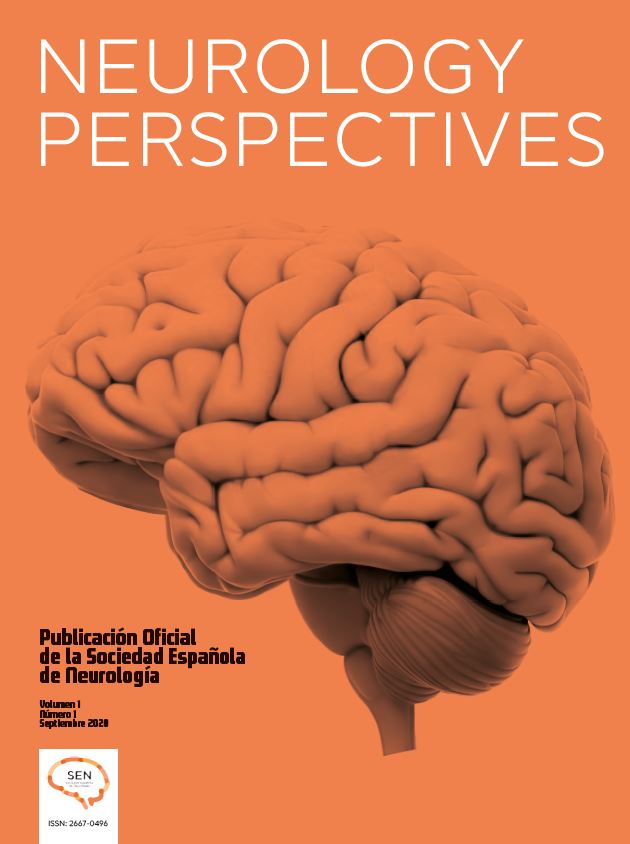Recessive mutations in the ANO5 gene may manifest in several ways: limb girdle muscular dystrophy, distal myopathy, asymptomatic hyperCKaemia, or as a pseudometabolic disorder.1 The latter 2 presentations are the mildest and possibly the most frequent forms, with a frequency of 74% in a Spanish series of 20 patients.2 Generalised use of muscle MRI studies and next-generation sequencing (NGS) and/or exome sequencing has enabled the diagnosis of many previously unclassified dystrophy subtypes.
We present a case of asymptomatic hyperCKaemia as the initial manifestation of anoctaminopathy diagnosed in an elderly patient. During the 8-year follow-up period, no weakness has been observed, although clinical symptoms have progressed as exercise intolerance and myalgia.
Our patient was a 74-year-old woman who attended our department due to hyperCKaemia. Her medical history included dyslipidaemia, temporal meningioma, gastritis, spondyloarthritis, and vitamin D deficiency. Her parents were non-consanguineous. The patient was the third of 4 siblings; the fourth also presented hyperCKaemia and has been assessed at another centre, with no diagnosis being established. She reported no myalgia, weakness, cramps, or fatigue, nor had she ever previously presented exercise intolerance. Physical examination revealed muscle strength of 5/5 in the cervical muscles and in the proximal and distal muscles of the limbs, with symmetrical reflexes. The patient was able to stand without difficulty from a low-seated position, and showed no axial weakness or scapular winging; she presented asymmetrical atrophy of the left gastrocnemius muscle (Fig. 1). Complementary testing showed CPK levels of up to 1384 U/L, no myopathic pattern on EMG, and symmetrical fatty infiltration in both adductor magnus muscles on thigh MRI. An MRI scan of the calf muscles revealed asymmetrical atrophy of the medial gastrocnemius muscle (Fig. 2). A biopsy study of the vastus lateralis muscle yielded normal results. We requested an exome sequencing study, which detected 2 pathogenic variants: c.191dup p.(Asn64Lysfs*15) and c.692G>T p.(Gly231Val) in heterozygosis in the ANO5 gene; these findings are compatible with limb girdle muscle dystrophy recessive 12 (LGMDR12). An echocardiography study revealed a slight dilation of the aortic root, measuring 50×48 mm. After 8 years of follow-up, the patient has presented myalgia and mild cramps in the lower limbs, but no weakness in the gastrocnemius or proximal muscles. Her ability to walk has remained intact.
Thigh and gastrocnemius MRI study.
a) Coronal T1-weighted sequence: symmetrical fatty infiltration in the adductor magnus muscle.
b) Axial T1-weighted sequence: symmetrical fatty infiltration in the adductor magnus muscle (arrow).
c) Axial FLAIR sequence: no hyperintensity was observed in any muscle.
d) Coronal T1-weighted sequence: fatty infiltration in the medial gastrocnemius muscle (star).
e) Axial T1-weighted sequence: fatty infiltration in the medial gastrocnemius muscle (star).
The reported patient represents a case of asymptomatic hyperCKaemia identified during her elderly years. We initially requested an MRI study to determine the muscle groups involved, to guide the genetic study. The recent review of girdle dystrophies by Johnson et al.3 underscored the relevance of MRI studies in understanding the spectrum of muscle involvement in each subtype. One example is the more predominant involvement (in the form of fatty infiltration) of the posterior compartment in LGMDR1, or the more extensive involvement of both the posterior and anterior compartments in LGMDR2. Our patient presented involvement of the posterior compartment of the thigh and medial gastrocnemius muscle, coinciding with the muscular involvement pattern described to date in anoctaminopathies. A study by Holm-Yildiz et al.4 describes and compares muscle MRI and muscle biopsy results in 17 and 24 patients, respectively, with mutations in the ANO5 gene. The authors report that up to 82% of patients showed oedema/inflammation (hyperintense lesions on STIR sequences) in several muscles, at different locations in each muscle, with asymmetrical involvement, in all stages of the disease and in all phenotypes, consistent with the inflammatory signs in the histological study. Most patients presented partial fatty replacement on T1-weighted sequences. There is universal consensus that the most frequently affected muscles are the adductor and semi-membranosus muscles of the thigh and the medial section of the gastrocnemius and soleus muscles.1–3,5 Our case shows involvement of the typical muscular locations in the adductor magnus and medial gastrocnemius muscles, as well as atypical signs such as symmetrical involvement of the adductor muscles. Initially, we did not suspect this dystrophy. The normal results of the muscle biopsy were of little value, with the sample probably having been obtained from an unaffected muscle. Normal histological patterns have been described in anoctaminopathies, together with more characteristic findings such as interstitial amyloid deposition, especially in cases of homozygous c.191dupA mutation1,6; similar inflammatory changes to those observed in other inflammatory dystrophies or myopathies2–4; and the presence of ragged red fibres.7
Anoctaminopathies rarely affect respiratory muscles but frequently involve cardiac muscle, probably due to the high expression of ANO5 in that muscle.1 In our opinion, this finding, which appeared to be coincidental in our patient and is common at a certain age (aneurysmal dilation of the aortic root at the age of 78 years, when the study was performed), may be part of the clinical phenotype of this type of dystrophy, which involves a wide spectrum of cardiac involvement, from dilated cardiomyopathy to heart rate abnormalities.1,8,9
Clinical progression after 8 years of follow-up is consistent with that reported by Panades-de Oliveira et al.2 in a series of 20 patients, all of whom presented milder forms of the spectrum: asymptomatic or mild hyperCKaemias with no reported weakness during follow-up.
In conclusion, we describe the case of a recessive mutation in the ANO5 gene with initial symptoms of asymptomatic hyperCKaemia at an advanced age and without progression to fixed weakness after 8 years of follow-up. We hope to stress the relevance of diagnosing genetically determined myopathies at any age, with the support of an MRI study to guide the genetic study.









